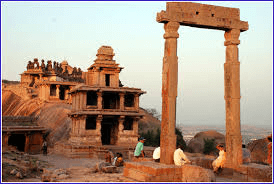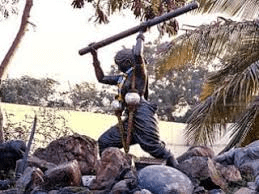
Have you ever wondered how a single act of courage could change the course of history? How did Onake Obavva, an ordinary woman, become a symbol of bravery in Indian history? And what role did the magnificent Chitradurga Fort play in shaping this story?
Table of Contents

Chitradurga Fort stands as an architectural and historical marvel, echoing tales of valiant warriors and strategic brilliance. Among its many legends, the story of Onake Obavva remains a testament to courage, proving that a single act of bravery can alter history. This article explores the significance of Chitradurga Fort, the heroic tale of Onake Obavva, and the timeless lessons embedded in its walls.

Situated in the rugged landscapes of Chitradurga, India, Chitradurga Fort, also known as Elusuttina Kote (Fort of Seven Circles), is an exemplary structure built over centuries by various ruling dynasties. Its construction dates back to the 11th century under the Chalukyas, later expanded by the Hoysalas and Nayakas of Chitradurga, who fortified it against external invasions.
Chitradurga is located 200 km from Bangalore, making it a pleasant three-hour ride. The fort itself is just 1 km away from the Chitradurga bus stop, making it easily accessible for visitors.
| Feature | Details |
| Location | Chitradurga, India |
| Built By | Chalukyas, Hoysalas, Nayakas |
| Unique Features | Seven concentric walls, rainwater harvesting, hidden passages |
| Historical Significance | Key stronghold in battles against Hyder Ali and Tipu Sultan |

The fort’s design is an outstanding example of ancient military engineering. Its seven concentric walls provided multiple layers of defense, making it nearly impenetrable. The use of natural rock formations blended seamlessly with artificial fortifications, offering strategic advantages against enemies.
Key architectural features include:
Flow chart


Onake Obavva, an ordinary woman with extraordinary courage, played a crucial role in defending Chitradurga Fort. She was the wife of a guard assigned to monitor a kindi (a small crevice in the fort wall), a vulnerable entry point often exploited by enemies.
In 1779, the Chitradurga Fort in Karnataka faced one of its most significant threats under the siege of Hyder Ali, the ruler of Mysore. The fort, ruled by Madakari Nayaka, was renowned for its impenetrable defenses, including its seven concentric walls. However, Hyder Ali's forces discovered a vulnerability—a narrow crevice in the fort wall, known as the kindi, through which soldiers could crawl one at a time.
Obavva, the wife of Kahale Mudda Hanuma, a guard stationed at the fort. On that fateful day, Hanuma had left his post near the kindi to have lunch. As Obavva went to fetch water from a nearby well, she overheard muffled voices and noticed enemy soldiers attempting to infiltrate through the crevice. Realizing the imminent danger and with no time to alert her husband or other guards, she decided to act on her own.
Rushing back home, Obavva grabbed an onake—a long wooden pestle traditionally used for pounding grain—and returned to the kindi. Hiding near the crevice, she waited for each soldier to emerge. With remarkable precision and strength, she struck down each intruder as they crawled through the narrow passage. One by one, she killed them with a single blow to the head and quietly moved their bodies out of sight to avoid raising suspicion among the remaining soldiers.
By the time her husband returned from lunch, he was met with a shocking scene: Obavva standing amidst a pile of enemy corpses, her pestle stained with blood. Together, they raised an alarm and joined forces with other defenders to repel the remaining attackers. Her actions delayed Hyder Ali’s forces significantly and gave Chitradurga’s soldiers critical time to prepare for battle.
Tragically, Onake Obavva's heroism came at a great cost. She was found dead later that day—accounts differ on whether she was killed by enemy soldiers or succumbed to shock from her ordeal. Despite her sacrifice and valiant efforts, Chitradurga Fort eventually fell to Hyder Ali in 1779 due to overwhelming enemy forces.
Onake Obavva’s name has since become synonymous with courage, resilience, and quick-witted action. Her legacy is honored through:
Today, Onake Obavva is celebrated as a symbol of courage and resilience in Karnataka. The crevice she defended is now known as Obavvana Kindi and remains a popular historical site. Her story is immortalized in folklore and continues to inspire generations as an enduring testament to bravery in the face of overwhelming odds.
Chitradurga Fort serves as an invaluable case study in military strategy. Some of its key defense mechanisms include:
| Strategy | Application in Chitradurga Fort |
| Layered Defense | Seven walls created multiple barriers against invaders |
| Water Conservation | Advanced rainwater harvesting ensured sustainability |
| Topographical Advantage | Built on rocky terrain, making attacks difficult |
| Secret Passages | Enabled covert military movements |
The tale of Onake Obavva is a powerful reminder that history is shaped not only by kings and warriors but also by unsung heroes. Her story teaches us:
| Aspect | Ancient (Chitradurga Fort) | Modern Strategies |
| Defense Mechanisms | Concentric walls, hidden passages | Advanced surveillance, cyber defense |
| Water Management | Rainwater harvesting | Modern desalination plants |
| Individual Contribution | Heroes like Onake Obavva | Specialized military units |
The story of Chitradurga Fort and Onake Obavva is one of resilience, strategic brilliance, and heroic determination. As we explore the fort’s historical significance and architectural marvels, we uncover lessons that remain relevant in today’s world.
So, the next time you visit Chitradurga, India, make sure to walk through the grand Chitradurga Fort and pay homage to Onake Obavva’s indomitable spirit.
Want to explore more such historical gems? Check out our latest blogs and uncover India’s rich heritage today!
Onake Obavva is renowned for her courage and heroism in the history of Chitradurga Fort. She single-handedly fought against Hyder Ali's soldiers, defending the fort with unwavering bravery until her last breath
Chitradurga Fort stands as a testament to the strategic insight and bravery of the valiant Nayakas of Chitradurga. With its seven enclosures, the fort has withstood the test of time and the forces of nature for centuries. The courage of the Nayakas earned the region the title “Gandu Mettida Nadu,” meaning the Land of Masculine Prowess.
Obavvana Kindi, named after the brave Onake Obavva, is the small crevice in Chitradurga Fort through which Hyder Ali's soldiers attempted to sneak in. Onake Obavva, known as a symbol of Kannada female pride, single-handedly defended the fort by fighting off the intruders with a pestle (onake). Her heroic act is immortalized in Karnataka’s history.
Due to its impressive design featuring multiple layers of defense, Chitradurga Fort is also known as Elusuttina Kote, which translates to "Fort of Seven Circles." This name highlights the seven concentric walls that made the fort nearly impenetrable.
The construction of Chitradurga Fort spans several centuries, beginning as early as the 11th century. The initial structure was established by the Chalukyas, with subsequent expansions and fortifications added by the Hoysalas and Nayakas of Chitradurga. Each dynasty left its mark, enhancing the fort's defenses and architectural features.
Chitradurga Fort boasts several remarkable features that showcase ancient military engineering prowess. These include the seven concentric walls providing layered defense, interconnected water reservoirs demonstrating advanced rainwater harvesting techniques, hidden passages used for strategic movements and emergency evacuations, and strategically positioned watchtowers and bastions for effective surveillance.
Onake Obavva's legacy is honored through various means, including the annual celebration of Onake Obavva Jayanti, the erection of statues and memorials in Chitradurga, and the inclusion of her inspiring story in school curriculums to educate future generations about her valor and sacrifice.

JAIN PU College, a part of the renowned JGI Group, is committed to empowering students with quality education.
Beyond academics, the college ensures its online content reflects the same standard of excellence. Every blog and article is meticulously vetted and proofread by subject matter experts to ensure accuracy, relevance, and clarity. From insightful educational topics to engaging discussions, JAIN PU College's content is crafted to inform, inspire, and add value to its readers, reflecting the institution's commitment to intellectual growth and innovation.
View all Blogs